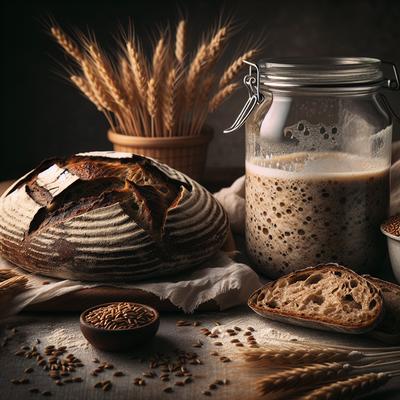Sourdough Starter and Sourdough Rye Bread
Master the art of traditional baking with this comprehensive recipe for **Sourdough Starter and Sourdough Rye Bread**, a delightful journey into homemade sourdough from scratch. This recipe combines the tangy flavor of a naturally fermented sourdough starter with the rich, earthy notes of rye flour to create a hearty, artisan loaf with a crisp crust and soft, chewy interior. The process begins by cultivating a vibrant, bubbly starter over a week, followed by a methodical bread-making technique that includes key steps like autolysis, stretch-and-fold kneading, and slow fermentation for optimal texture and flavor development. Infused with optional caraway seeds for a classic touch, this bread is perfect for sandwiches, toasts, or standalone enjoyment. Ideal for both beginners and seasoned bakers, this guide transforms simple ingredients like whole wheat flour, bread flour, and rye flour into a bakery-worthy masterpiece. Get ready to fill your kitchen with the irresistible aroma of freshly baked sourdough!
Try SnapCalorie's FREE AI assisted nutrition tracking free in the App store or on Android.

Scan with your phone to download!

Ingredients
- 120 grams Whole wheat flour (for starter)
- 120 ml Water (for starter)
- 60 grams Unbleached all-purpose flour (to feed starter)
- 60 ml Water (to feed starter)
- 150 grams Active sourdough starter
- 200 grams Rye flour (for bread)
- 300 grams Bread flour
- 375 ml Water (for bread)
- 10 grams Salt
- 1 tablespoon Caraway seeds (optional)
Directions
Step 1
Step 1: Make the sourdough starter. In a clean, non-metallic bowl, combine 120 grams of whole wheat flour and 120 ml of water. Stir thoroughly, cover loosely with a breathable cloth, and set in a warm area (21-25°C/70-77°F).
Step 2
Step 2: Feed the starter daily. Discard half (about 120 grams) of the starter and add 60 grams of unbleached all-purpose flour and 60 ml of water. Stir and cover. Repeat this process for 5-7 days, until the starter is bubbly, tangy-smelling, and doubles in size within 4-6 hours after feeding.
Step 3
Step 3: Prepare for the bread. On baking day, ensure the sourdough starter is active by feeding it 4-6 hours before baking. It should be bubbly and airy when ready to use.
Step 4
Step 4: In a large mixing bowl, combine 150 grams of active sourdough starter, 375 ml of water, 200 grams of rye flour, and 300 grams of bread flour. Mix until a shaggy dough forms.
Step 5
Step 5: Autolyse the dough. Cover the bowl with a damp cloth and let it rest for 30 minutes to hydrate the flour.
Step 6
Step 6: Add 10 grams of salt (and caraway seeds if using). Knead the dough gently or stretch and fold it until the salt is fully incorporated, about 5 minutes.
Step 7
Step 7: Perform bulk fermentation. Transfer the dough to a clean, oiled bowl. Cover and let it rise in a warm area for 4-5 hours, performing a stretch-and-fold every 30 minutes for the first 2 hours.
Step 8
Step 8: Shape the dough. Turn the dough out onto a floured surface, shape it into a round or oval loaf, and transfer it to a floured banneton or bowl. Cover and let it proof for 1-2 hours at room temperature or overnight in the refrigerator.
Step 9
Step 9: Preheat the oven and baking vessel. Place a Dutch oven or baking stone in the oven and preheat to 230°C (450°F).
Step 10
Step 10: Bake the bread. When ready, carefully transfer the dough onto parchment paper, score the top with a sharp knife or razor, and place it into the hot Dutch oven. Cover and bake for 20 minutes. Remove the lid and bake for another 20-25 minutes until the crust is dark and crisp.
Step 11
Step 11: Cool the bread. Remove the bread from the oven and let it cool on a wire rack for at least 1 hour before slicing.
Nutrition Facts
| Serving size | (1409.0g) |
|---|
| Amount per serving | % Daily Value* |
|---|---|
| Calories | 2492.5 |
| Total Fat 13.2g | 0% |
| Saturated Fat 2.0g | 0% |
| Cholesterol 0mg | 0% |
| Sodium 3948.9mg | 0% |
| Total Carbohydrate 525.7g | 0% |
| Dietary Fiber 57.6g | 0% |
| Total Sugars 3.5g | |
| Protein 77.1g | 0% |
| Vitamin D 0IU | 0% |
| Calcium 207.3mg | 0% |
| Iron 25.9mg | 0% |
| Potassium 1884.6mg | 0% |
Source of Calories
